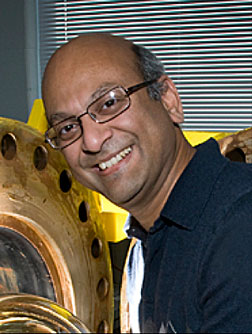- Number 381 |
- February 4, 2013
Long baseline neutrino experiment moves forward

Milind Diwan, Brookhaven Lab physicist and
LBNE co-spokesperson.
According to current understanding, the most abundant particle in the universe is the neutral, almost massless, and virtually undetectable neutrino.
In recent years, technological improvements have revealed that neutrinos have tiny masses, and they constantly change (oscillate) their “flavor” (muon, electron, or tau), a property that governs their interactions with all matter. Moreover, the oscillation frequency depends on the mass differences of the three known neutrinos.
A new project is needed to synthesize this new understanding and, perhaps, finally address a central question in particle physics: What happened to all the anti-matter in the universe? If the oscillating behavior of neutrinos is different from anti-neutrinos, it could hint at how the difference between matter and anti-matter arose in the early universe, eventually leading to matter domination.
The new project, the Long Baseline Neutrino Experiment (LBNE), would consist of an intense, pure beam of high-energy neutrinos produced at a proton accelerator at Fermilab and sent more than 1,000 kilometers to a large detector capable of detecting neutrinos of the electron and muon flavors. Opportunities for discoveries would be great, especially if the detector had sensitivity over a wide energy range and low background interference from cosmic rays.
Brookhaven Lab scientists have had a central role in understanding and contributing to the science of neutrinos (including Brookhaven Lab chemist Ray Davis’s seminal work that led to the 2002 Nobel Prize in Physics), and promoting the scientific case for LBNE as a world-class project. Over the last decade, plans for this proposal have been debated with the wider particle physics community.
The Department of Energy and the National Science Foundation encouraged the LBNE scientific collaboration by funding design work, establishing a project office at Fermilab, and forming a partnership for project construction, including the underground facility. But the NSF’s participation stopped in 2011 due to budget constraints.
During 2011, the science collaboration together with Fermilab narrowed down the technological choices for the project, examining the scientific and technological impacts as well as the cost and schedule. In late 2011, the physicists involved decided that the far detector would be a very large cryogenic detector full of liquid argon instead of a detector full of water. After these decisions, DOE asked the collaboration to divide the program into phases so that the first phase would fit within the affordable budget.
One last piece had to fall in place: The physicists needed to know if electron neutrinos had a small, but measurable likelihood of oscillation corresponding to the largest mass difference amongst the three neutrinos. Such an effect would be a prerequisite for a successful LBNE science program. The effect was demonstrated spectacularly earlier this year by the Daya Bay reactor experiment with all other measurements in good agreement.
The experimental configuration for phase I of LBNE is now a new Fermilab-based neutrino beam aimed toward the Homestake site in South Dakota, 1,300 kilometers away, and a 10,000-ton liquid argon detector. To fit within DOE’s budget, the liquid argon detector will not be located very deep in the mine (which would be costly).
In December, the project reached the next step, Critical Decision 1 (CD1), which formally establishes the site and cost range of the project. The entire team is excited to meet the challenges moving forward.Submitted by DOE’s Brookhaven National Laboratory
